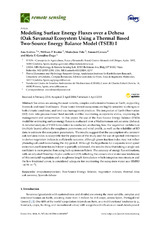Modeling Surface Energy Fluxes over a Dehesa (Oak Savanna) Ecosystem Using a Thermal Based Two-Source Energy Balance Model (TSEB) I
Autor
Andreu, Ana
Kustas, William P.
Polo Gómez, María José
Carrara, Arnaud
González-Dugo, Maria P.
Editor
MDPIFecha
2018Materia
EvapotranspirationTwo-Source Energy Balance
Vegetation indexes
Thermal data
Oak savanna
Spanish dehesa
METS:
Mostrar el registro METSPREMIS:
Mostrar el registro PREMISMetadatos
Mostrar el registro completo del ítemResumen
Savannas are among the most variable, complex and extensive biomes on Earth, supporting
livestock and rural livelihoods. These water-limited ecosystems are highly sensitive to changes in
both climatic conditions, and land-use/management practices. The integration of Earth Observation
(EO) data into process-based land models enables monitoring ecosystems status, improving its
management and conservation. In this paper, the use of the Two-Source Energy Balance (TSEB)
model for estimating surface energy fluxes is evaluated over a Mediterranean oak savanna (dehesa).
A detailed analysis of TSEB formulation is conducted, evaluating how the vegetation architecture
(multiple layers) affects the roughness parameters and wind profile, as well as the reliability of EO
data to estimate the ecosystem parameters. The results suggest that the assumption of a constant
oak leaf area index is acceptable for the purposes of the study and the use of spectral information
to derive vegetation indices is sufficiently accurate, although green fraction index may not reflect
phenological conditions during the dry period. Although the hypothesis for a separate wind speed
extinction coefficient for each layer is partially addressed, the results show that taking a single oak
coefficient is more precise than using bulk system coefficient. The accuracy of energy flux estimations,
with an adjusted Priestley–Taylor coefficient (0.9) reflecting the conservative water-use tendencies
of this semiarid vegetation and a roughness length formulation which integrates tree structure and
the low fractional cover, is considered adequate for monitoring the ecosystem water use (RMSD
~40W m-2).

